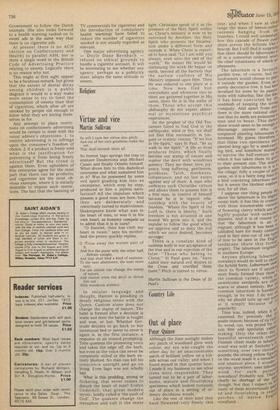Country Life
Out of place
Peter Quince
Although the June sunlight makes any patch of woodland glow with colour, my eye was caught the other day by an unaccountable patch of brilliant yellow on a hillside across our valley; and when I found myself in that quarter later, I made it my business to see what trees were responsible. They turned out to be a pair of laburnums, mature and flourishing specimens which looked curiously, out of place in a setting of ordinary deciduous woods.
Like the rest of their kind they have flowered very freely this
year, and when I saw at close range the mass of lemon-yellow racemes hanging from the branches, I could well understand, how this cascade of flower could shine across the hillside like 8 beacon. But I still find it surprising that there should be laburnurrls 8,1 all in a somewhat isolated wooc, the chief inhabitants of which are pheasants. .te The laburnum is a favourgarden tree, of course, but landowners would choose to Plan' it outside the garden. Even as a purely decorative tree, it has been devalued for some by its assoc' tions with suburbia; like the lilac it has been convicted by the snobbish of keeping the wrong company. And apart from that there is the more rational Ann' tion that its seeds are poisonous°, man and to beast. This defed' alone would seem to be enough° discourage anyone who c°1; templated planting laburnums do', farmland. My guess, therefore, that these two specimens were planted long ago by a seed-cacrYeil ing bird, and somehow' manag, to survive the half-century or which it has taken them to WI to their present size. The neace. garden with laburnums in it is les the village, fully a couple of crliel,,er away, sb it is a fairly long haul IA'. a bird conveying laburnum see,' but it seems the likeliest expla5e.
tion, for all that. 'Re I suppose one thing people Ilk, about the laburnum is its slight'v exotic look; it has this in conull.°5 with those innumerable varietleo of flowering cherry which area's, highly popular with suburba'; planters. And it is of course that the laburnum is an migrant, although it has been tablished here for many centunl,s (and in fact nine out of ten tYP` of tree to be seen in the Englil landscape share this foreigej origin). The laburnum originat in southern Europe. Anyone planting laburclu nowadays would do well to chu°0 the hybrid form, Laburnum yes , since its flowers are if anythinoj more freely formed than thoseq the common variety, while t's,f unwelcome seedpods are eithhe scarce or absent entirely. But tre common laburnum is handsonl se enough, in its way. I do not why we should turn up our 00 at it simply because of I popularity. Time was, indeed, when it esteemed for precisely the posite reason; because of its rarle,i, Its wood, too, was prized Tot cet, tam n fine and specialist cabill making. Only the other daY0 beautiful seventeenth centulf, Flemish chest made in laburnnfor wood was sold at Sotheby's something over two thousnio pounds; the strong yellow figun'oe on the wood made it a remackaii and unusual piece. I wondeCo anyone, anywhere, uses laburnne; wood for such purP°!ji nowadays? Probably not. Thee:0 clearly no shortage of the t7iod though. Not that I expect to Psi', many of them mysteriously Pln„te ed and flourishing in renVisp patches of native Eng' woodland.


































 Previous page
Previous page